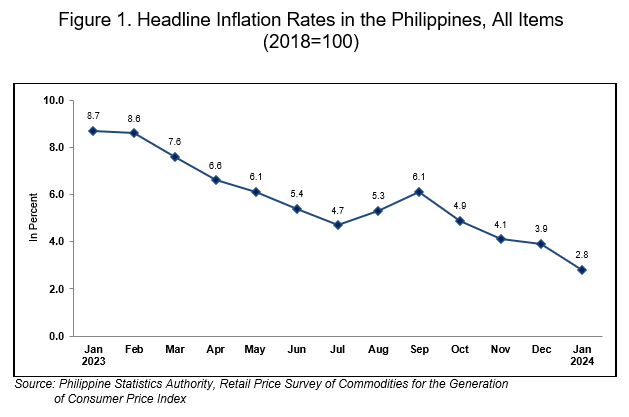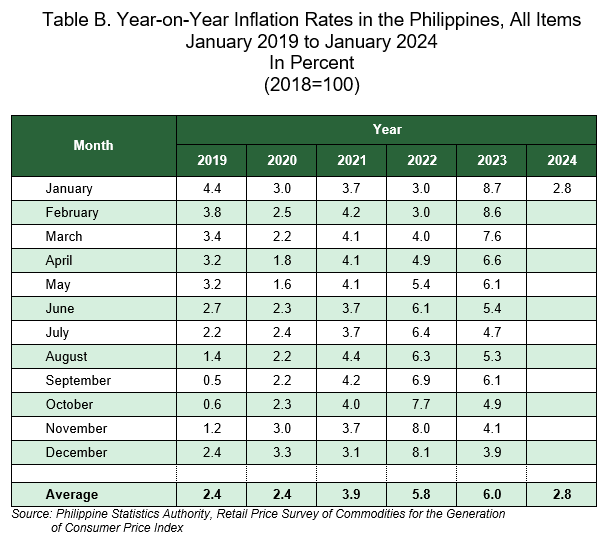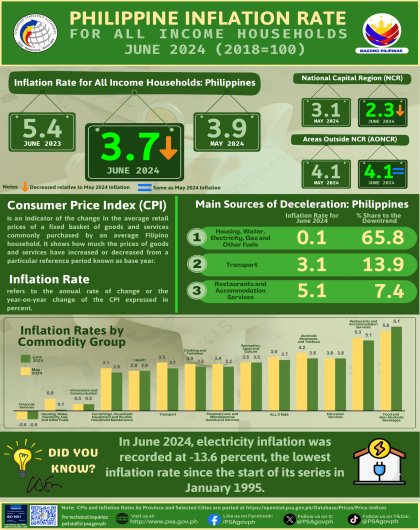Summary Inflation Report Consumer Price Index (2018=100): June 2024
Table A. Year-on-Year Inflation Rates, All Items
In Percent
(2018=100)
|
|
|
|
|
|---|---|---|---|---|
| Philippines | ||||
| Headline | 8.7 | 3.9 | 2.8 | 2.8 |
| Core | 7.4 | 4.4 | 3.8 | 3.8 |
| NCR | ||||
| Headline | 8.6 | 3.5 | 2.8 | 2.8 |
| AONCR | ||||
| Headline | 8.7 | 4.0 | 2.8 | 2.8 |
| Source: Philippine Statistics Authority, Retail Price Survey of Commodities for the Generation of Consumer Price Index *Year-on-year change of CPI for January 2024 vs. 2023 | ||||

A. Philippines
1. Headline Inflation
The Philippines’ headline inflation or overall inflation slowed down further to 2.8 percent in January 2024. This is the lowest inflation rate since the 2.3 percent inflation rate recorded in October 2020. Inflation rate was recorded at 3.9 percent in December 2023, while it was 8.7 percent in January 2023. (Figure 1, and Tables A, B, 5, and 14)
1.1 Main Drivers to the Downward Trend of the Headline Inflation
The downtrend in the overall inflation in January 2024 was primarily brought about by the slower annual increment of food and non-alcoholic beverages at 3.5 percent in January 2024 from 5.4 percent in the previous month. Also contributing to the downtrend was housing, water, electricity, gas and other fuels with slower annual increase of 0.7 percent during the month from 1.5 percent in December 2023.
Lower annual increments were also noted in the indices of the following commodity groups during the month:
a. Alcoholic beverages and tobacco, 8.4 percent from 9.0 percent;
b. Clothing and footwear, 3.8 percent from 4.2 percent;
c. Furnishings, household equipment and routine household maintenance, 3.9 percent from 4.5 percent;
d. Health, 3.3 percent from 3.7 percent;
e. Recreation, sport and culture, 4.0 percent from 4.2 percent;
f. Restaurants and accommodation services, 5.5 percent from 5.6 percent; and
g. Personal care, and miscellaneous goods and services, 4.0 percent from 4.6 percent.
In addition, annual decreases were noted in the indices of transport at 0.3 percent in January 2024 from 0.4 percent annual increase in the previous month, and financial services at 0.6 percent annual decrease during the month from zero percent annual rate in December 2023.
On the contrary, the index of education services exhibited a higher annual increase of 3.8 percent during the month from an annual increment of 3.5 percent in December 2023.
The index of information and communication remained at its previous month’s annual rate of 0.5 percent. (Tables 5 and 6)
1.2 Main Contributors to the Headline Inflation
The top three commodity groups contributing to the January 2024 overall inflation were the following:
a. Food and non-alcoholic beverages with 47.1 percent share or 1.3 percentage points;
b. Restaurants and accommodation services with 18.9 percent share or 0.5 percentage point; and
c. Alcoholic beverages and tobacco with 6.5 percent share or 0.2 percentage point.
2. Food Inflation
Food inflation at the national level eased to 3.3 percent in January 2024 from 5.5 percent in the previous month. In January 2023, food inflation was higher at 11.2 percent. (Table 9)
2.1 Main Drivers to the Downward Trend of Food Inflation
The deceleration of food inflation in January 2024 was primarily brought about by the faster year-on-year decline in the index of vegetables, tubers, plantains, cooking bananas and pulses at 20.8 percent during the month from 9.2 percent annual decrease in December 2023. Fish and other seafood also contributed to the downtrend with a slower inflation rate of 1.2 percent in January 2024 from 4.8 percent in December 2023.
In addition, annual declines were noted in the indices of the following food groups during the month:
a. Corn, -4.3 percent from -3.5 percent;
b. Oils and fats, -4.3 percent from -3.6 percent;
c. Meat and other parts of slaughtered land animals, -0.7 percent from 0.2 percent; and
d. Sugar, confectionery and desserts, -1.0 percent from 0.1 percent.
Moreover, lower inflation rates during the month were noted in the following food items:
a. Flour, bread and other bakery products, pasta products, and other cereals, 5.6 percent from 6.3 percent;
b. Milk, other dairy products and eggs, 5.6 percent from 7.4 percent;
c. Fruits and nuts, 10.0 percent from 12.2 percent; and
d. Ready-made food and other food products not elsewhere classified, 4.7 percent from 5.0 percent.
On the contrary, rice inflation increased further to 22.6 percent during the month from 19.6 percent in December 2023. (Tables 7 and 13)
2.2 Main Contributors to the Food Inflation
Food inflation shared 43.3 percent or 1.2 percentage points to the overall inflation in January 2024. The food groups with the highest contribution to the food inflation during the month were the following:
a. Cereals and cereal products, which includes rice, corn, flour, bread and other bakery products, pasta products, and other cereals, with 111.6 percent share or 3.7 percentage points;
b. Milk, other dairy products and eggs with 9.0 percent share or 0.3 percentage point; and
c. Fruits and nuts with 8.3 percent share or 0.3 percentage point. (Table 9)
3. Core Inflation
Core inflation, which excludes selected food and energy items, decelerated to 3.8 percent in January 2024 from 4.4 percent in the previous month. In January 2023, core inflation was higher at 7.4 percent. (Tables A, 11, and 17)

B. National Capital Region (NCR)
Following the trend at the national level, inflation rate in NCR also decelerated to 2.8 percent in January 2024 from 3.5 percent in December 2023. In January 2023, inflation rate in the area was recorded at 8.6 percent. (Tables A, 5, and 15)
The lower inflation rate in NCR was mainly influenced by the slower annual increase in the housing, water, electricity, gas and other fuels index at 3.3 percent in January 2024 from 4.8 percent in the previous month. Also contributed to the downtrend were the slower annual increases observed in the food and non-alcoholic beverages at 1.9 percent during the month from 2.8 percent in December 2023, and restaurants and accommodation services with a year-on-year increase of 4.7 percent in January 2024 from 5.3 percent in the previous month.
Likewise, lower year-on-year mark-ups were noted in the indices of the following commodity groups during the month:
a. Furnishings, household equipment and routine household maintenance, 4.3 percent from 5.0 percent;
b. Health, 2.7 percent from 2.9 percent;
c. Transport, 0.2 percent from 0.4 percent;
d. Recreation, sport and culture, 1.9 percent from 2.0 percent; and
e. Personal care, and miscellaneous goods and services, 3.6 percent from 3.8 percent.
The financial services index recorded an annual decrement of 0.1 percent during the month from zero percent annual rate in the previous month.
In contrast, higher annual increments in January 2024 were observed in the indices of alcoholic beverages and tobacco at 6.7 percent from 6.2 percent; clothing and footwear, 2.4 percent from 2.3 percent; information and communication, 0.2 percent from 0.1 percent; and education services, 3.9 percent from 3.3 percent. (Tables 5 and 6)
C. Areas Outside NCR (AONCR)
Inflation rate in AONCR, likewise, decelerated to 2.8 percent in January 2024 from 4.0 percent in December 2023. Inflation in the area in January 2023 was higher at 8.7 percent. (Tables A, 5, and 16)
The deceleration of inflation in AONCR was mainly due to the slower annual increase in the food and non-alcoholic beverages index at 3.7 percent during the month from 5.9 percent in December 2023. Inflation in the area was also pulled down by the annual declines in the indices of housing, water, electricity, gas and other fuels at 0.3 percent and transport at 0.4 percent in January 2024, both from 0.4 percent annual increase in December 2023.
Moreover, slower annual rates were observed in the indices of the following commodity groups during the month:
a. Alcoholic beverages and tobacco, 8.7 percent from 9.5 percent;
b. Clothing and footwear, 4.0 percent from 4.5 percent;
c. Furnishings, household equipment and routine household maintenance, 3.7 percent from 4.3 percent;
d. Health, 3.4 percent from 3.8 percent;
e. Recreation, sport and culture, 4.4 percent from 4.7 percent;
f. Restaurants and accommodation services, 5.6 percent from 5.8 percent; and
g. Personal care, and miscellaneous goods and services, 4.1 percent from 4.7 percent.
The financial services index recorded an annual decline of 0.8 percent during the month from zero percent annual rate in the December 2023, while the indices of the rest of the commodity groups remained at their respective previous month’s year-on-year increments. (Tables 5 and 6)
All regions outside NCR recorded slower inflation rates during the month relative to their respective December 2023 inflation rates. In January 2024, Region II (Cagayan Valley), for the fourth consecutive month, and Region I (Ilocos Region) registered the lowest inflation rate at 1.5 percent, while Region XI (Davao Region) had the highest inflation rate of 4.4 percent. (Table 6)
Note: CPIs and inflation rates by province and selected city are posted at the PSA OpenSTAT portal at https://openstat.psa.gov.ph/PXWeb/pxweb/en/DB/DB__2M__PI__CPI__2018/?tablelist=true.
CLAIRE DENNIS S. MAPA, PhD
Undersecretary
National Statistician and Civil Registrar General
See more at the CPI and Inflation Rate main page.


